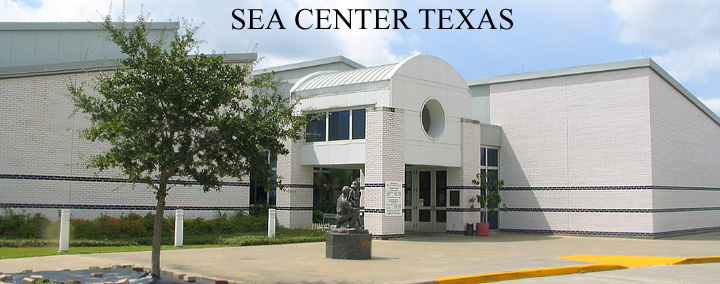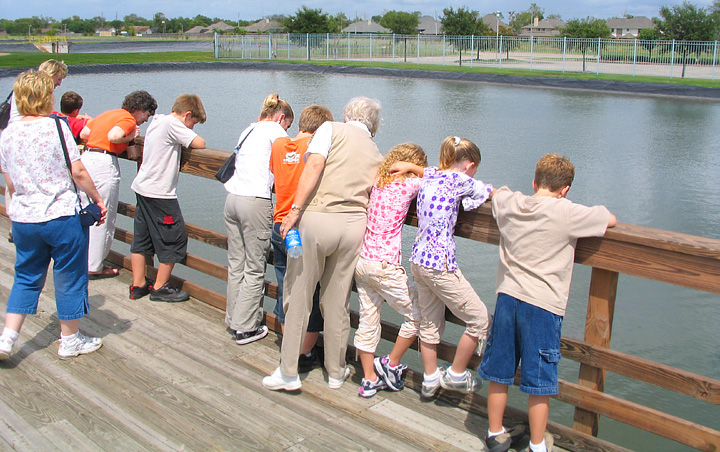 |
 |
|
|
| Sea Center Texas
is a one-of-a-kind marine fish hatchery and Visitor's Center located on 75
acres in Lake Jackson, Texas.
The $13 million facility opened in March, 1996 and includes a
15,000-square foot Visitor's Center housing several aquaria and
educational displays of the marine life of Texas bays and Gulf waters, the
largest red drum hatchery in the world used to produce larvae for stocking
grow-out ponds and conducting research on stressed fish stocks from Texas
waters, 35 acres of grow out ponds and a 5+ acre interpreted marsh areas. |
|
| There are many exhibits
at Sea Center Texas including the Touch Pools, Salt Marsh, Coastal Bay,
Jetty, Artificial Reef, and the Offshore exhibit. The two twelve foot
Touch Pools allow visitors to handle marine animals such as blue crabs,
hermit crabs, starfish, urchins snails and anemones. The salt marsh is the first area encountered when visiting the beach. A section of coastal salt marsh displayed in a 1,000-gallon aquarium with a window more than 14 feet long. Here you can see mud and fiddler crabs, shrimp, periwinkles, killifish and other aquatic organisms in their natural habitat. At the coastal bay aquarium you will view spices such as red drum, spotted sea trout, and snook cruising through 2200 gallons of water over a sand, mud and oyster bottom.
|
A 5000 gallon jetty
exhibit nearly fills the back wall of the center. Granite blocks and
boulders re-create a man-made jetty as the aquarium's back-ground.
Barnacles, periwinkle, and other shelled animals encrust wooden pilings
and rocks that spill across the bottom while finfish like sergant majors,
sheepshead, groupers and spadefish hover among the pilings.
|
| Tarpon, jack crevalle ,
pompano and spot swim in the 5000-gallon artificial reef exhibit.
Looking into this aquarium, you will experience the only break in a seemingly limitless background that fades from the surf zone out toward the open Gulf. Offshore Gulf Of Mexico Gordon the 225-lb grouper flaps his fins slowly and from his position at the front of the tank stares back at amazed onlookers. |
|
| Red drum, tarpon,
mackerel, dolphin fish or other open water fish stay of of the way of the
4-8 foot sharks slowly circling over the sand bottom. The Hatchery building is a utilitarian facility, engineered for low maintenance, semi-intensive fish production. The high-tech life support systems are tailored for species such as red drum and spotted seatrout. Fish for the Visitors Center aquaria along with broodfish to produce larvae for stocking fingerlings grow-out ponds will be maintained throughout the hatchery. |
|
| Volunteer Shirley Smith
points out the various marine life and explains how the reproduction of
broodstock is maintained, to school kids that took the educational tour. Thirty-five acres of fish culture ponds are used for growing larvae to 1-inch fingerlings. One half-acre pond is included for special projects and research. Seawater is obtained from an intake 5 miles from the hatchery site on Dow Inc. property. Seawater is pumped into the storage reservoir behind the hatchery for use in filing the ponds. Adjacent to the Visitor's Center is a 5-acre marsh area that includes shallow ponds, fresh and salt water marsh areas, and elevated walkways across the site with large decks for extended marsh viewing. |
|
 |
More Texas Cities and Towns
|
If you would like to
see more Texas cities just click on the link below for the Texas Cities
and Towns home page.
Including Quintana, Surfside, Alvin, Sugarland, Pearland, Galveston and more... |
|
|
|
|
|
|
All content copyright George L. Hosek. The articles, photographs and videos on this site are for viewing on your computer only, absolutely, no commercial or personal reproduction without written consent from George Hosek. |